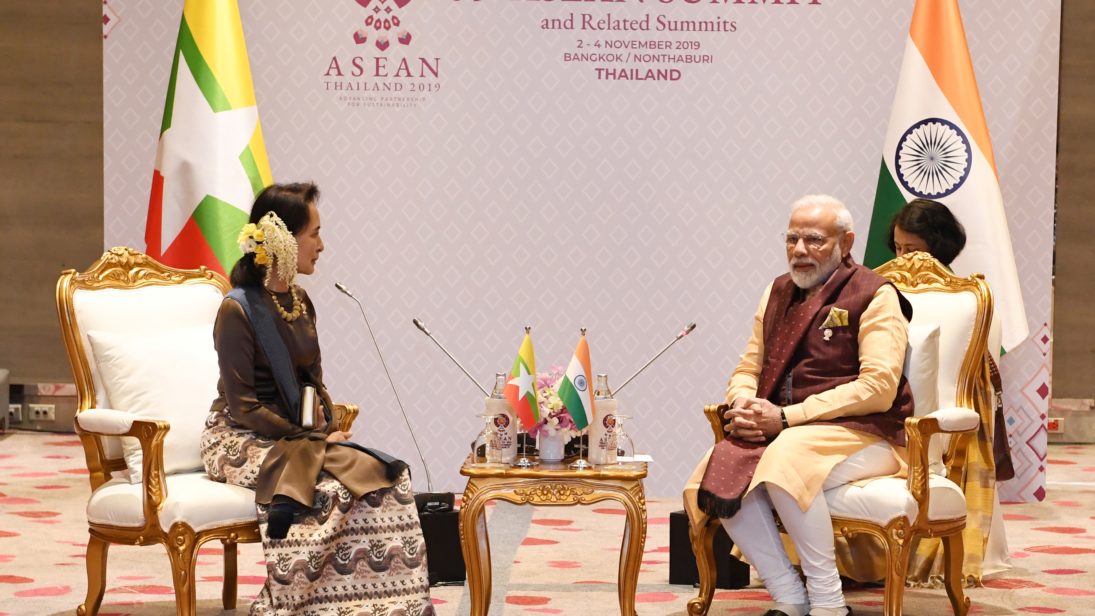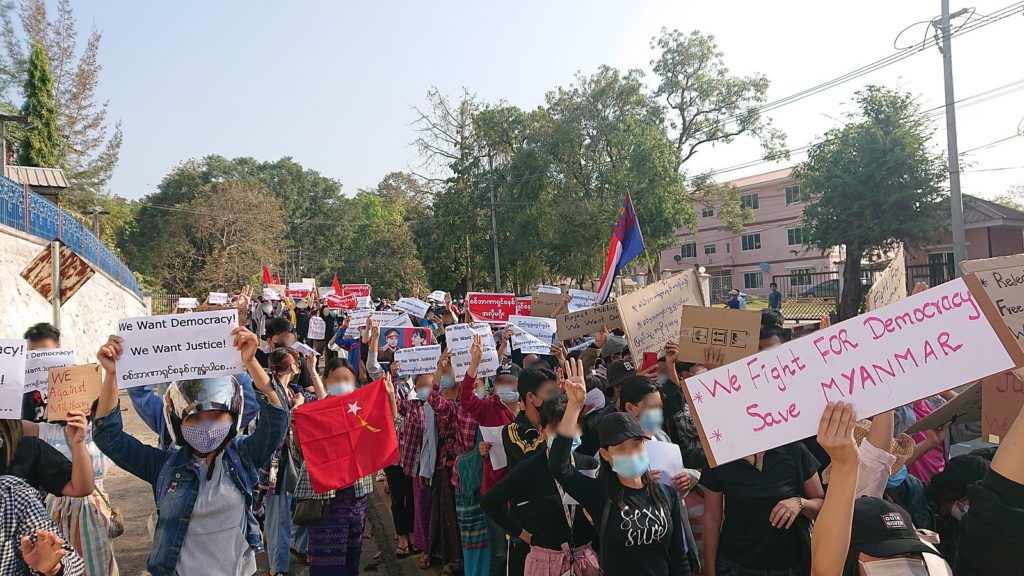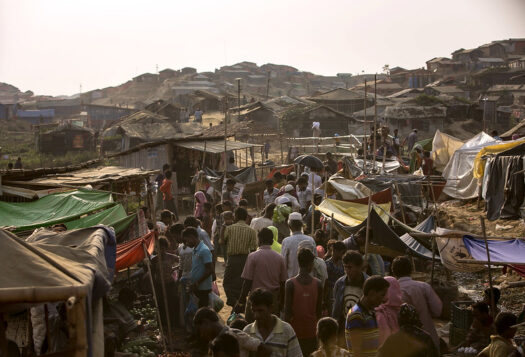
Since the military seized power earlier in February, Myanmar has been weathering unprecedented turmoil. The military junta’s violent crackdown on public pro-democracy protests has claimed more than 1100 lives. Despite the crisis attracting global attention and calls for international intervention, India, Myanmar’s nearest democratic neighbor, has maintained a cautious neutrality and not taken a proactive approach to the ongoing violence. Alongside a long-held policy of non-interference in other countries’ affairs, India’s approach stems from a need to balance its support for democratic ideals and securing its strategic interests. In the case of Myanmar, these two priorities are at odds. A stated support for democracy means solidarity with the Burmese protesters and strained relations with the military, whereas closer ties with the military mean negative perception among the Burmese public.
In the strategic space, New Delhi worries losing political space to China. The uncertain future of infrastructure and development projects worth about USD $650 million, and the Myanmar military’s commitment to fight anti-India insurgents operating from Myanmar’s soil, shape India’s current approach. However, a balancing act that tilts Indian foreign policy marginally towards the undemocratic Junta raises questions about India’s ability to maintain close ties to Myanmar in the long run—public support for India in Myanmar is critical to long-term ties. India must increase its outreach to Myanmar citizens to manage its interests and security. Public engagements through providing greater humanitarian assistance—including vaccines and shelter to citizens and refugees—can help bolster people-to-people connections and, to some extent, improve public perceptions of India.
India’s Skewed Balancing Act
India’s attempts to maintain ties with Myanmar regardless of which leader sits at its helm shape India’s current response to the Junta. In the aftermath of the coup, India was silent about the unfolding crisis, hoping to bide time to formulate a more effective response and avoid ruffling feathers of the Junta. Unfazed by the crisis, the Indian defense attaché in Myanmar attended a military parade on the occasion of Myanmar’s annual Armed Forces Day on March 27. India adopted a lukewarm policy towards Myanmar citizens seeking refuge in India for fear of persecution by the military junta. At first, India banned the cross-border inflow of refugees into the country despite huge public pressure from its north-eastern states to provide them asylum; it later softened the stance, allowing some refugees to stay in the country.
A balancing act that tilts Indian foreign policy marginally towards the undemocratic Junta raises questions about India’s ability to maintain close ties to Myanmar in the long run—public support for India in Myanmar is critical to long-term ties.
India also avoided explicitly naming the Junta in condemning the violence in Myanmar and signaled its willingness to work with the Junta. Further, Delhi’s reluctance to initiate a discussion on the crisis at the Bay of Bengal Initiative for Multi-Sectoral Technical and Economic Cooperation (BIMSTEC) ministerial meet—and its subsequent absence from the UN General Assembly resolution against the military takeover—distinctly marked India’s tilt towards the Junta. India has also refused to join the countries imposing sanctions on Myanmar and is also believed to have watered down the Quadrilateral Security Dialogue’s response to the crisis.
The Limits of India’s Strategy and the Need for Public Diplomacy
The Indian government must replace this excessive tilt towards the Junta with a policy of guarded distance through public diplomacy engagements. Public diplomacy denotes influencing and shaping foreign public opinion in favor of the foreign policy interests of the state practicing it. It essentially involves perception management and building and maintaining cordial relations with foreign publics. The potentially enduring hostility between the public and the Junta government includes an inherent public dimension. Nowhere is this need for public dimension more apparent than the consolidation of public perception around the Junta as their principal enemy. This is reflected in the National Unity Government’s (NUG) political turnaround to reproach with the Rohingyas and several rebel groups coming forward to fight the Junta.
Moreover, the Burmese public’s call for solidarity from foreign governments—exhibited in public demonstrations in several foreign capitals, including Delhi—points to their feelings of helplessness and desire for global support against the Junta. Foreign responses to the enduring democratic crisis in Myanmar are likely to shape the Burmese public attitude towards said foreign actors. Attacks on China’s factories and business houses in Myanmar are a case in point, indicating a growing feeling of estrangement. These confrontational dynamics may become more entrenched and linger into the future.

In this context, India’s tilt towards the Junta may feed pre-existent and growing negative public perceptions of India in Myanmar. Delhi faced significant criticism for the Indian defense attaché’s participation in the military parade on the occasion of Myanmar’s annual Armed Forces Day. The Indian public sector unit (PSU) Bharat Electronics Limited (BHEL)’s military supply to the Junta further stoked public anger and resentment. Such public disenchantment and frustration are not surprising given India’s democratic identity, close people-to-people linkages, and geographic proximity with Myanmar. Any perceived lack of support to ease their hardship can turn public opinion hostile towards India.
The strategic significance of managing public discontent lies in the fact that India needs Myanmar’s public support for its Act East Policy. The need for public diplomacy is critical to India’s subnational engagements, in which border north-eastern states play a role in forging and building mutual trust between both countries. India’s current approach of making its own state governments like Mizoram and Manipur hostile to the central government can impact cooperative federalism, killing the potential of the states for subregional diplomacy. Furthermore, cordial ties with the northeast are important for thwarting the potential rise of anti-India insurgencies. Finally, the rationale for securing the hearts and minds of the people is also closely tied to how India should prepare for a change of government in Myanmar.
Way Forward: Public Diplomacy Measures
Delhi should provide refuge to the Myanmar citizens fleeing the country. While subnational efforts of states of Mizoram and Manipur to support the fleeing population will contribute partially to people-to-people ties, India must do more to provide humanitarian assistance in the form of accepting refugees. Humanitarian support to secure human rights and peace is at the heart of democracy promotion.
Overall, these efforts can help project India positively among the people of Myanmar without implicating it in intra-national dynamics of the state-society hostility.
India should also explore more avenues to reset relations between the government in exile—the National Unity Government (NUG)—and the military. While continuing to provide medical assistance to Myanmar, Delhi should consider supporting the anti-coup protesters. Notably, China is providing vaccines to both the Junta and the rebels. India should positively respond to any calls for international assistance to facilitate a non-junta, non-political body to coordinate COVID-19 emergency medical assistance to the people of Myanmar who do not trust the Junta’s assistance.
Overall, these efforts can help project India positively among the people of Myanmar without implicating it in intra-national dynamics of the state-society hostility. This approach would improve foreign perceptions of India’s commitment to democracy while also securing its strategic interests in Myanmar in the event of another regime change.
***
Image 1: Ministry of External Affairs, India via Flickr
Image 2: Wikimedia Commons


